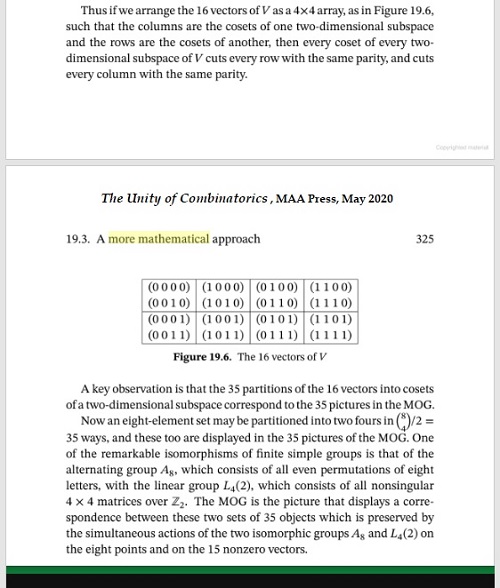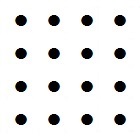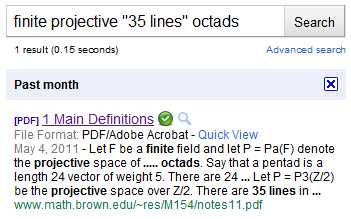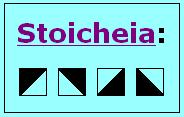
Monday, March 24, 2025
Elegy in a Cartoon Graveyard
Monday, June 1, 2020
The Gefter Boundary
“The message was clear: having a finite frame of reference
creates the illusion of a world, but even the reference frame itself
is an illusion. Observers create reality, but observers aren’t real.
There is nothing ontologically distinct about an observer, because
you can always find a frame in which that observer disappears:
the frame of the frame itself, the boundary of the boundary.”
— Amanda Gefter in 2014, quoted here on Mayday 2020.
See as well the previous post.
Wednesday, May 20, 2020
Thursday, February 7, 2019
Geometry of the 4×4 Square: The Kummer Configuration
From the series of posts tagged Kummerhenge —
A Wikipedia article relating the above 4×4 square to the work of Kummer —

A somewhat more interesting aspect of the geometry of the 4×4 square
is its relationship to the 4×6 grid underlying the Miracle Octad Generator
(MOG) of R. T. Curtis. Hudson's 1905 classic Kummer's Quartic Surface
deals with the Kummer properties above and also foreshadows, without
explicitly describing, the finite-geometry properties of the 4×4 square as
a finite affine 4-space — properties that are of use in studying the Mathieu
group M24 with the aid of the MOG.
Thursday, July 12, 2018
Kummerhenge Illustrated
“… the utterly real thing in writing is the only thing that counts…."
— Maxwell Perkins to Ernest Hemingway, Aug. 30, 1935
"Omega is as real as we need it to be."
— Burt Lancaster in "The Osterman Weekend"
Tuesday, May 29, 2018
The Schwartz Meme
Aficionados of the preposterous joke
(see yesterday's post Epstein on Art)
may consult a Google Image Search for
Schwartz Meme.
I prefer Schwartz même —

Tuesday, March 7, 2017
Signature Backdrop
"The Bitter End’s signature stage backdrop —
a bare 150-year-old brick wall — helped distinguish it from
other popular bohemian hangouts like the Village Gate
and the Village Vanguard. It appeared on the cover of
Peter, Paul and Mary’s first album."
— The New York Times this evening on a Sunday death
“Looking carefully at Golay’s code is like staring into the sun.”
See also Schwartz in "The Omega Matrix," a post of 5 PM ET Sunday:
Sunday, March 5, 2017
The Omega Matrix
Tuesday, May 24, 2016
Rosenhain and Göpel Revisited
The authors Taormina and Wendland in the previous post
discussed some mathematics they apparently did not know was
related to a classic 1905 book by R. W. H. T. Hudson, Kummer's
Quartic Surface .
"This famous book is a prototype for the possibility
of explaining and exploring a many-faceted topic of
research, without focussing on general definitions,
formal techniques, or even fancy machinery. In this
regard, the book still stands as a highly recommendable,
unparalleled introduction to Kummer surfaces, as a
permanent source of inspiration and, last but not least,
as an everlasting symbol of mathematical culture."
— Werner Kleinert, Mathematical Reviews ,
as quoted at Amazon.com
Some 4×4 diagrams from that book are highly relevant to the
discussion by Taormina and Wendland of the 4×4 squares within
the 1974 Miracle Octad Generator of R. T. Curtis that were later,
in 1987, described by Curtis as pictures of the vector 4-space over
the two-element Galois field GF(2).
Hudson did not think of his 4×4 diagrams as illustrating a vector space,
but he did use them to picture certain subsets of the 16 cells in each
diagram that he called Rosenhain and Göpel tetrads .
Some related work of my own (click images for related posts)—
Rosenhain tetrads as 20 of the 35 projective lines in PG(3,2)
Göpel tetrads as 15 of the 35 projective lines in PG(3,2)
Related terminology describing the Göpel tetrads above

Monday, June 15, 2015
Slow Art
Slowness is sometimes in the eye of the beholder.
See this journal on Slow Art Day 2015.
Related material: Epistemic States in this journal.
Omega Matrix
See that phrase in this journal.
See also last night's post.

The Greek letter Ω is customarily used to
denote a set that is acted upon by a group.
If the group is the affine group of 322,560
transformations of the four-dimensional
affine space over the two-element Galois
field, the appropriate Ω is the 4×4 grid above.
Friday, August 15, 2014
The Omega Matrix
The webpage Rosenhain and Göpel Tetrads in PG(3,2)
has been updated to include more material on symplectic structure.
Wednesday, August 13, 2014
Stranger than Dreams*
Illustration from a discussion of a symplectic structure
in a 4×4 array quoted here on January 17, 2014 —
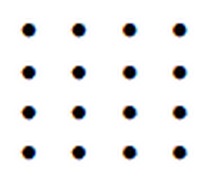
See symplectic structure in this journal.
* The final words of Point Omega , a 2010 novel by Don DeLillo.
See also Omega Matrix in this journal.
Thursday, August 7, 2014
The Omega Mystery
See a post, The Omega Matrix, from the date of her death.
Related material:
"When Death tells a story, you really have to listen."
— Cover of The Book Thief

A scene from the film of the above book —

“Looking carefully at Golay’s code is like staring into the sun.”
Some context — "Mathematics, Magic, and Mystery" —
See posts tagged April Awareness 2014.
Tuesday, August 5, 2014
The Omega Story
|
"We tell ourselves stories in order to live…. We interpret what we see, select the most workable of multiple choices. We live entirely, especially if we are writers, by the imposition of a narrative line upon disparate images, by the 'ideas' with which we have learned to freeze the shifting phantasmagoria which is our actual experience." |
See also a post from May 4, 2011 (the date, according to a Google
search, of untitled notes regarding a matrix called Omega).
Monday, August 4, 2014
A Wrinkle in Space
"There is such a thing as a tesseract." — Madeleine L'Engle
An approach via the Omega Matrix:
See, too, Rosenhain and Göpel as The Shadow Guests .
Sunday, August 3, 2014
The Omega Matrix
Shown below is the matrix Omega from notes of Richard Evan Schwartz.
See also earlier versions (1976-1979) by Steven H. Cullinane.

Backstory: The Schwartz Notes (June 1, 2011), and Schwartz on
the American Mathematical Society's current home page:
Wednesday, June 1, 2011
The Schwartz Notes
A Google search today for material on the Web that puts the diamond theorem
in context yielded a satisfyingly complete list. (See the first 21 results.)
(Customization based on signed-out search activity was disabled.)
The same search limited to results from only the past month yielded,
in addition, the following—
This turns out to be a document by one Richard Evan Schwartz,
Chancellor’s Professor of Mathematics at Brown University.
Pages 12-14 of the document, which is untitled, undated, and
unsigned, discuss the finite-geometry background of the R.T.
Curtis Miracle Octad Generator (MOG) . As today’s earlier search indicates,
this is closely related to the diamond theorem. The section relating
the geometry to the MOG is titled “The MOG and Projective Space.”
It does not mention my own work.
See Schwartz’s page 12, page 13, and page 14.
Compare to the web pages from today’s earlier search.
There are no references at the end of the Schwartz document,
but there is this at the beginning—
These are some notes on error correcting codes. Two good sources for
this material are
• From Error Correcting Codes through Sphere Packings to Simple Groups ,
by Thomas Thompson.
• Sphere Packings, Lattices, and Simple Groups by J. H. Conway and N.
Sloane
Planet Math (on the internet) also some information.
It seems clear that these inadequate remarks by Schwartz on his sources
can and should be expanded.
Wednesday, November 5, 2003
Wednesday November 5, 2003
"Everything that has a beginning
has an end."
— The Matrix Revolutions

Matrix, by Knots, Inc., 1979.
"Easy to master — A lifetime to enjoy!"
The object for 2 players (8-adult)
is to be the first to form a line
consisting of 4 different
colored chips.
Imagist Poem
(Recall the Go-chip
in Wild Palms.)







